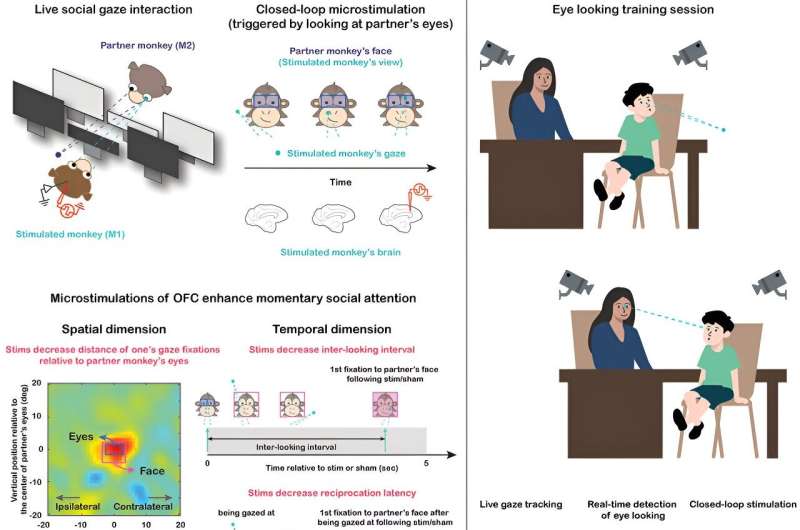This article has been reviewed according to Science X's editorial process and policies. Editors have highlighted the following attributes while ensuring the content's credibility:
fact-checked
peer-reviewed publication
trusted source
proofread
More than meets the eye: Understanding how the brain controls social gaze

For animals such as primates, the act of gazing plays a key role in social interaction, used to both send and gather information. In a new study, Yale scientists uncover two brain regions that contribute to this type of social attention.
The findings yield important insight into how this dynamic behavior arises and might be used to boost social behavior in disorders like autism in which engaging in social attention can be challenging, researchers say.
The findings were published May 31 in the journal Neuron.
For primates, social gaze is an integral part of social interaction, says Steve Chang, an associate professor of psychology and neuroscience in Yale's Faculty of Arts and Sciences and senior author of the study.
"For example, monkeys want to see what others are looking at because there might be more resource opportunities," said Chang. "But eye contact that lasts a long time could also be a threatening gesture. So there's this intricate balance of when to look at the eyes of another to get information but not send the wrong information."
In a previous study, Chang and his colleagues identified brain regions in the prefrontal-amygdala brain networks where neural activity increased as monkeys gazed at each other. For the new study, they wanted to determine to what extent these regions caused social gazing behavior.
To do so, the researchers paired two rhesus macaque monkeys and then used infrared cameras to track the eye positions of both monkeys. When one of the monkeys looked at the other's eyes, it received a tiny, real-time stimulation in one of three brain regions. The researchers then tracked whether and how the stimulated monkey's gaze changed.
They found that after receiving stimulation in one of the regions—a prefrontal cortical region called the orbitofrontal cortex—monkeys' spontaneous gazes were more concentrated around their partners eyes for the next several seconds and the time in between gazes was much shorter, compared with monkeys that did not receive a stimulation.
"Stimulation in this region also reduced the amount of time it took for a monkey to reciprocate another's gaze," said Chang. "But none of these findings occurred when monkeys were in a non-social interaction, looking at a moving dot rather than another monkey's eyes."
Stimulation within the other two brain regions—the dorsomedial prefrontal cortex and the gyrus of the anterior cingulate cortex—did not yield the same effects.
However, stimulation to the dorsomedial prefrontal cortex did have a unique longer-term effect not observed within the other regions. Over the stimulation sessions, which lasted 1.5 hours, stimulation to the dorsomedial prefrontal cortex altered how gazes were exchanged between two monkeys.
"The gazes of partner monkeys were interacting over time in a kind of leader-follower pattern," said Chang. "Over the course of the stimulations, this relationship strengthened, but only with stimulations to the dorsomedial prefrontal cortex."
Together, the findings reveal the important contributions these two brain regions offer when it comes to both momentary and long-term social gaze interaction. Knowing how these regions contribute to social interactions, and social gaze specifically, reveals where interventions could be focused to boost social behavior where it's diminished, said Chang.
"We can envision a future therapeutic approach that builds on these findings using a social brain-computer interface," he said, "where we target these regions to enhance in-the-moment and long-term social attention."
More information: Siqi Fan et al, Closed-loop microstimulations of the orbitofrontal cortex during real-life gaze interaction enhance dynamic social attention, Neuron (2024). DOI: 10.1016/j.neuron.2024.05.004

















